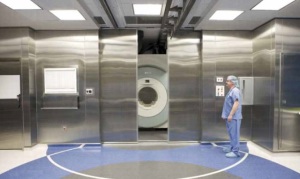by
Nancy Ryerson, Staff Writer | October 22, 2013
From the October 2013 issue of HealthCare Business News magazine
For radiologists, image quality is everything. When Emanuel Kanal, a Pittsburgh radiologist, first noticed a thin line cutting through his otherwise clear images, he was immediately concerned. Soon, random streaks that looked like rain dripping down a window appeared on his images. As a consultant to the FDA on MR safety issues, it didn’t take long for him to figure out the image-spoiling culprit: a compromised RF shield.
“The adhesive that we had used for our shielding in the wall was failing,” he says. “At that point, we had to replace the shield and it was a massive undertaking.”
RF shields can dutifully protect MRI scanners from radio frequency for upwards of two decades, but even a small puncture in a shield or a slight installation mistake can mean tainted images and a major headache for the imaging facility.



Ad Statistics
Times Displayed: 45604
Times Visited: 1365 MIT labs, experts in Multi-Vendor component level repair of: MRI Coils, RF amplifiers, Gradient Amplifiers Contrast Media Injectors. System repairs, sub-assembly repairs, component level repairs, refurbish/calibrate. info@mitlabsusa.com/+1 (305) 470-8013
From materials to testing down the road, there are a number of decisions you’ll need to make to maximize a shield’s life. To help you make those important decisions, shielding experts shared their best advice based on their experiences.
Material world
Copper and galvanized steel are the two most common RF-shielding choices, along with aluminum, which can also be used. Most facilities make a choice based on price, which fluctuates from year to year. Recently, copper and galvanized steel have held steady at around the same price, though copper has historically been more expensive.
Besides price, another factor that can impact material choice is whether the site requires protection from electromagnetic interference in addition to RF shielding. MRI manufacturers generally perform a test to measure EMI levels when evaluating a site.
“If you have EMI issues generated by power lines, transformers or electrical systems, you may want to put in a galvanized shield, and you may want to do shields of different thickness,” says Joel Kellogg, product line manager at shielding company ETSLindgren. “For example, if someone puts in an eighth inch of galvanized steel and an eighth inch of aluminum, they’re going to get some additional shielding benefit for EMI, which in most applications isn’t required, but it could help make a site acceptable to the magnet vendor.”
Today, more facilities are also interested in shielding to dampen MRI sound as well.
“People don’t want to hear the MRI outside of the room, so they’re adding acoustic doors and acoustic materials,” says Howard Newman, vice president of Universal Shielding Corp. While choosing materials can be a challenge, selecting a vendor shouldn’t be. Bill Mansfield, owner of Professional Installations and an RF shield tester, says that shielding companies have become much more reliable over the last 10 years. Still it pays to research who you’re working with to get the most for your money.

